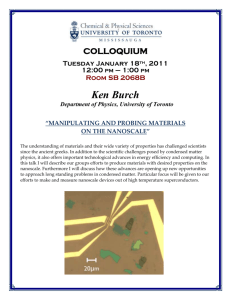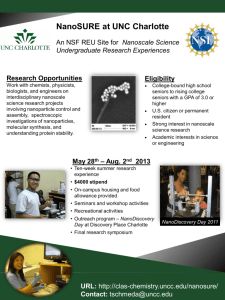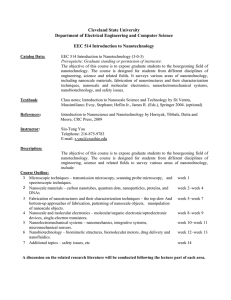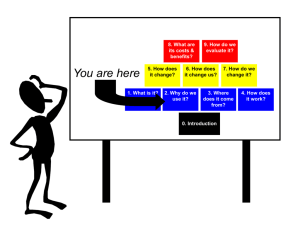The Masters Training Package in Nanoscale Science and Technology*
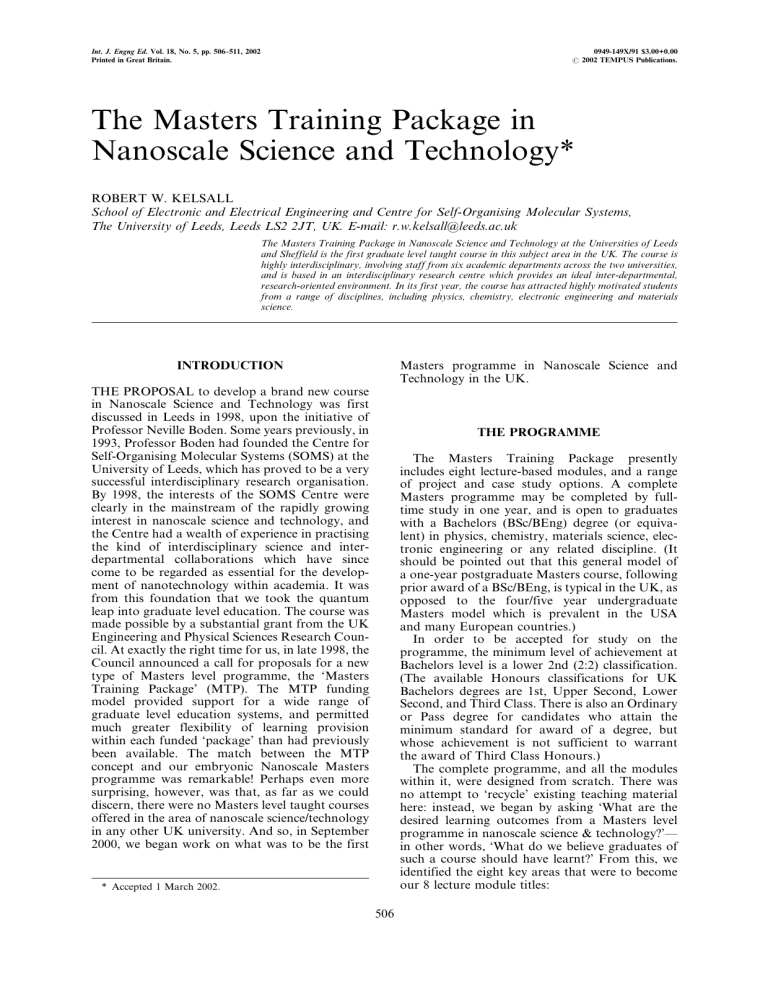
Int. J. Engng Ed.
Vol. 18, No. 5, pp. 506±511, 2002
Printed in Great Britain.
0949-149X/91 $3.00+0.00
# 2002 TEMPUS Publications.
The Masters Training Package in
Nanoscale Science and Technology*
ROBERT W. KELSALL
School of Electronic and Electrical Engineering and Centre for Self-Organising Molecular Systems,
The University of Leeds, Leeds LS2 2JT, UK. E-mail: r.w.kelsall@leeds.ac.uk
The Masters Training Package in Nanoscale Science and Technology at the Universities of Leeds and Sheffield is the first graduate level taught course in this subject area in the UK. The course is highly interdisciplinary, involving staff from six academic departments across the two universities, and is based in an interdisciplinary research centre which provides an ideal inter-departmental, research-oriented environment. In its first year, the course has attracted highly motivated students from a range of disciplines, including physics, chemistry, electronic engineering and materials science.
INTRODUCTION
THE PROPOSAL to develop a brand new course in Nanoscale Science and Technology was first discussed in Leeds in 1998, upon the initiative of
Professor Neville Boden. Some years previously, in
1993, Professor Boden had founded the Centre for
Self-Organising Molecular Systems (SOMS) at the
University of Leeds, which has proved to be a very successful interdisciplinary research organisation.
By 1998, the interests of the SOMS Centre were clearly in the mainstream of the rapidly growing interest in nanoscale science and technology, and the Centre had a wealth of experience in practising the kind of interdisciplinary science and interdepartmental collaborations which have since come to be regarded as essential for the development of nanotechnology within academia. It was from this foundation that we took the quantum leap into graduate level education. The course was made possible by a substantial grant from the UK
Engineering and Physical Sciences Research Council. At exactly the right time for us, in late 1998, the
Council announced a call for proposals for a new type of Masters level programme, the `Masters
Training Package' (MTP). The MTP funding model provided support for a wide range of graduate level education systems, and permitted much greater flexibility of learning provision within each funded `package' than had previously been available. The match between the MTP concept and our embryonic Nanoscale Masters programme was remarkable! Perhaps even more surprising, however, was that, as far as we could discern, there were no Masters level taught courses offered in the area of nanoscale science/technology in any other UK university. And so, in September
2000, we began work on what was to be the first
* Accepted 1 March 2002.
Masters programme in Nanoscale Science and
Technology in the UK.
506
THE PROGRAMME
The Masters Training Package presently includes eight lecture-based modules, and a range of project and case study options. A complete
Masters programme may be completed by fulltime study in one year, and is open to graduates with a Bachelors (BSc/BEng) degree (or equivalent) in physics, chemistry, materials science, electronic engineering or any related discipline. (It should be pointed out that this general model of a one-year postgraduate Masters course, following prior award of a BSc/BEng, is typical in the UK, as opposed to the four/five year undergraduate
Masters model which is prevalent in the USA and many European countries.)
In order to be accepted for study on the programme, the minimum level of achievement at
Bachelors level is a lower 2nd (2:2) classification.
(The available Honours classifications for UK
Bachelors degrees are 1st, Upper Second, Lower
Second, and Third Class. There is also an Ordinary or Pass degree for candidates who attain the minimum standard for award of a degree, but whose achievement is not sufficient to warrant the award of Third Class Honours.)
The complete programme, and all the modules within it, were designed from scratch. There was no attempt to `recycle' existing teaching material here: instead, we began by asking `What are the desired learning outcomes from a Masters level programme in nanoscale science & technology?'Ð in other words, `What do we believe graduates of such a course should have learnt?' From this, we identified the eight key areas that were to become our 8 lecture module titles:
1. Generic methodologies in nanotechnology.
2. Semiconductor nanotechnology.
3. Nanoscale magnetic materials and devices.
4. Processing and properties of inorganic nanomaterials.
5. Self-assembling nanostructured molecular materials and devices.
6. Macromolecules at interfaces and structured organic films.
7. Electronic and photonic molecular materials and devices.
8. Bio-nanotechnology.
A brief summary of the content of each module is given in the Appendix. Obviously, this list is not unique. Nanotechnology continues to defy precise definition: partly, to be frank, due to the rush of scientists and engineers keen to `re brand' their existing activities as `nanotechnology', but primarily, we believe, because the nature of the subject is divergent, rather than convergent. Yes, nanoscale science and technology is certainly concerned with functional systems of, or involving, nanoscale dimensions, but this fact implicitly places the subject area at a position where physics, chemistry, electronics, materials science and biology all meet, and the myriad of possibilities generated by the richness of this disciplinary mix results in a subject area which will continue to expand and evolve in scope for many years yet.
In this context then, our particular definition of a Nanoscale Science and Technology programme was influenced firstly, by our belief that education in nanotechnology as an emerging technology area must be accompanied by corresponding education in the underpinning nanoscale sciences, and that there are currently many exciting developments in nanoscale science which, at present, are too far removed from applications to be properly classed as nanotechnology, but are extremely interesting and illuminating in their own right. Secondly, by our belief, as expressed above, that interdisciplinarity is fundamental to nanotechnology, and must be strongly reflected in any education programme in this subject area. And thirdly, by our own research activities within the scope of nanoscale science and technology, and our desire to make accessible some of the new and exciting science involved in these.
Thus, whilst some of the 8 modules may be classified as, for example, `primarily physics'
(module 3), most are spread across at least one disciplinary interface; for example, module 6, which involves both physical and chemical properties of surfaces and interfaces; and some modules encompass aspects of three or more different disciplines, such as module 5, which involves physical, chemical and biological perspectives on self-organisation, and module 7, which includes the physical, chemical and electronic properties of molecular electronic systems and devices. Overall, the programme covers the full spectrum of disciplines that contribute to nanotechnology,
The Masters Training Package in Nanoscale Science and Technology 507 ranging from electronic and materials science engineering, through physics and chemistry, right to the biological sciences, and the `centre of mass' of the programme is consequently somewhere on the physics/chemistry interface.
Of course, this breadth of disciplinary coverage is only made possible by the involvement of academic staff from a wide range of disciplines, and our programme involves staff from physics, chemistry, materials, electronic engineering and biochemistry/biological sciences departments.
Some of the teaching staff are also based in the interdisciplinary SOMS Centre, which serves as the academic `home' for the course. The extent of inter-departmental collaboration on a single, coherent degree programme is a novel feature in itself, and certainly represents one of the major administrative successes (and administrative challenges!) of the course. Furthermore, the programme is delivered jointly by the Universities of Leeds and Sheffield. This inter-university collaboration was motivated by strong synergies in nanoscale science research at the two sites, and was aided, in concept at least, by the pre-existence of a `strategic alliance' between the two institutions, which are very similar in function and stature and are located only some 40 miles apart.
The dual-university nature of the course adds a further dimension to the interdisciplinary aspect: even following the adoption of the two-semester, modular course system in many UK universities
(including both Leeds and Sheffield), joint university degree programmes are still very rare. Our particular aim in this respect was that the Nanoscale Science and Technology programme should be fully shared between the two sites, yet should appear seamless to our students. So far, there are good indications that we have achieved this goal.
Four of the lecture modules are delivered in Leeds, and four in Sheffield. Lectures are scheduled so as to minimise the travel requirement between sites, without imposing an excessive lecture load in any single day.
In the second semester of the one-year full time
MSc programme, two Leeds-based and two
Sheffield-based modules are delivered, one day a week at each site. Thus, students only need to travel once each week, irrespective of whether they live in Leeds or Sheffield. The `free' days are used for project work, private study and assessment work. The schedule for the first semester is somewhat different: we decided that it was important for students to complete module 1 first, before commencing any of the other modules, since this module serves as an introduction to the whole course. Thus, module 1 is delivered (at
Leeds) in a concentrated two-week period.
Modules 2 and 3 are then delivered, `in parallel' at Sheffield, on a two-day-per-week basis, again, with the remaining days used for project, private study and assessment work. Module 4 is delivered at Leeds, at the end of the first semester, again in a two-week block.
508
Each module includes up to 20 lectures, plus tutorials and laboratory demonstrations. The
`concentrated' delivery of module 1 has proved very successful. Although the module is delivered in a much shorter time than usual, the number of lectures per day is no greater, on average, than in the more traditional university schedule, in which up to six lecture modules may be delivered, in parallel, in the same semester.
Because the scope of module 1 is very broad in itself, covering a wide range of nanotechnology fabrication/processing and characterisation techniques, the academic intensity of the schedule remains at an appropriate level. Because of the interdisciplinary nature of all the modules, each module is delivered by more than one member of staff, who are often based in different departments.
However, in our one concession to administrative convenience, at present, each module is delivered solely by either Sheffield-based or Leeds-based staff, although in future there should be no problem in relaxing this constraint, subject to scheduling practicalities, if academically desirable.
MANAGEMENT AND QUALITY
ASSURANCE
The programme is managed by an inter-university committee comprising the Course Director and
Deputy Director (one from each university), and the Head of the Department or Centre which serves as the administrative home for the course at each university. Overall management responsibility for the course will rotate from one site to the other every five years, and the appointments of the
Course Director and Deputy Director are made on a five-year basis.
The academic development and delivery of the programme is the responsibility of the Programme
Learning and Teaching Committee (PLTC), which comprises the four above individuals, plus the managers of each lecture (or project) module contained within the programme. The PLTC is therefore also an inter-university committee. The
PLTC meets on a quarterly basis, including a full programme review meeting at the end of each academic year. Both universities have well defined quality assurance processes, and the PLTC programme review is forwarded simultaneously to the relevant pre-existing School/Faculty learning and teaching committees at both sites, from which feedback is also received.
An external examiner has been appointed dually by Leeds and Sheffield universities, and an Examiners meeting, comprising the external examiner and the PLTC, meets once at the end of each semester. This approach means that, for this particular programme, there is a single assessment and examination process across the two universities, with all modules treated identically, irrespective of which university is responsible for them, and with no student either advantaged or
R. Kelsall disadvantaged by virtue of registration at one or other university. At present there is no provision for the joint award of a degree by the two universities, so each successful student receives his degree either from the University of Leeds, or from the University of Sheffield, dependent on where he/she has completed his/her project work.
WEB-BASED RESOURCES
The advent of the Internet has brought about much talk of `distance-learning' and `web-based courses'. On the contrary, the Nanoscale Science and Technology programme that we have designed to date follows a campus-based model. However, the joint-university nature of the course inevitably adds a distance-learning aspect, as there will always be times when students are remote from one of the sites. To cater for this, we have developed an extensive learning resources intranet, accessible from either the Leeds or Sheffield campuses. On the intranet reside copies of all course scheduling and teaching administration information, such as lecture timetables, assessment requirements and full specifications for each module, and corresponding assessment deadlines, as well as full copies of all lecture notes and handouts. Our on-line booklist includes direct links to the library catalogues at both Leeds and Sheffield
Universities, so that students can see straight away how many copies of any recommended book are available at each site.
We have also used the intranet to help address another key issue in our course: that of the widely different backgrounds of our students. We are currently inviting applications from candidates with first (Bachelors) degrees in physics, chemistry, materials science and electronic engineering (or any related disciplines). This already represents a very wide range of knowledge bases, and clearly certain modules will be more accessible to, for example, a chemist than to a physicist. This has been one of the key considerations in the detailed design of the module syllabi, with provision of adequate background material and supporting tutorials made in each case. In addition, we have also developed a substantial portfolio of on-line tutorials, in which we have integrated our own newly written material with links to selected external public domain sites which provide tutoriallevel descriptions of specific topics relevant to our programme. Our web-based tutorials also include active computer experiments, in which the students can enter data and control simulation programs via a web page, and view a graph of the results displayed in the same page (almost) instantaneously.
ASSESSMENT METHODS
The fact that we were designing a brand new course gave us the freedom to design the assessment
The Masters Training Package in Nanoscale Science and Technology methods from the beginning too. We adopted the philosophy throughout that, for each module, the assessment methods used should be those most appropriate for the required learning outcomes.
In most cases, this philosophy steered us away from the traditional fixed-duration, closed-book examination model, which we believe tends to encourage a narrow, compartmentalised approach to study, rather than the broad, interdisciplinary approach required for this course.
In general, each module typically has three assessment elements, for example, an essay or design project, an oral presentation of a particular topic, and a set (sets) of problems or a test/ examination. In each module, at least one of the assessment elements is designed to be, as far as possible, the product of each student's individual effort. For example, the oral presentation and essay assessment elements will both satisfy this criterion provided that each student is asked to cover a different topic. In other assessment elements, collaborative work by students is allowed, and in some (for example, the design project for one of the modules), it is actively encouraged. We were also careful to guard against an excessive requirement for written work (essays and reports). Whilst these were considered a very appropriate assessment medium, it was recognised that many science graduates do not have much experience, or training, in essay writing, and therefore the task can be very time consuming.
PROJECTS
The one-year full-time Masters (MSc) programme includes, in addition to the eight lecture-based modules, a major research-type project. This project is worth one third of the total credits for the MSc degree. A selection of projects, spanning a wide range of topics, is available at each site, and students are invited to select their top three project preferences. The project choices are submitted in the 4th week of the 1st semester, which allows students time both to complete the first module in its entiretyÐthus providing a comprehensive overview of nanoscale science and technology to help inform their decisionÐand to meet potential project supervisors from the Leeds and Sheffield campuses.
The project allocation process for the first year of the course has just been completed, and already we can draw some clear conclusions. Firstly, travel was a key consideration. Given that the project work involves a great deal of time spent on campus, all our students chose projects based at the University closest to their term-time home.
Secondly, our students tended to choose projects closest in subject area to their first (Bachelors) degree background. (Whilst this trend may be regarded as a `vote against interdisciplinarity', it must be appreciated that, because of the length of section.) allocated their first preference.
different departments.
509 the major projects, the choice of project title must be made early in the academic year, before our students have had extensive exposure to the full range of disciplines embodied in the Masters programme overall. However, although they could be loosely labelled as `physics-based', or
`chemistry-based', most of the projects were not purely single-discipline, as discussed later in this
Fortunately, within these constraints, we had provided a sufficient range of project options at each site that we were able to allocate every student one of their top three preferences, with most being
All the projects, at present, are experimentally oriented, and are based in one or more academic staff research laboratories. Thus, the projects provide the students with the opportunity to work with state-of-the-art nanotechnology facilities, including a range of fabrication, microscopy and characterisation equipment. Each project has a primary and a secondary supervisor. This arrangement is used partially to provide a second opinion for assessment, but also to enhance the interdisciplinarity of the projects. Many of the projects involve pairs of supervisors who work in different research areas, and in some cases the primary and secondary supervisors are based in
The major project has three main phases. The first phase involves primarily background reading, literature searches, project planning and theoretical work, in November and December of the fulltime year, culminating with the submission of a project planning document. The second phase, throughout the 11 teaching weeks of the second semester, involves laboratory-based studies in parallel with completion of the lecture modules, and is assessed by an interim project report and a continual assessment mark. The third phase of the project involves essentially full-time work on the project alone for a period of six weeks, ending with the submission of the final report.
An oral examination on the whole of the project is held (at which only the two supervisors are present) and students are also required to give a short public presentation during the third phase.
The public presentation is marked by two members of staff other than the student's project supervisors, to provide an additional breadth of opinion in the assessment process.
PART-TIME AND FLEXIBLE LEARNING
ARRANGEMENTS
In addition to the Masters degree, the Nanoscale
Science and Technology Masters Training Package also includes Postgraduate Diploma and Postgraduate Certificate awards. The Certificate may be awarded following successful completion of 40 out of the 120 credits available (Leeds University
510 credit ratings)Ðwhich involves completion of four lecture courses and associated assessment tasks, whilst the Diploma requires successful completion of 80 credits, which may be composed either of eight 10-credit lecture modules, or four lecture modules plus 40 credits of project/case study work. Any of the Certificate, Diploma, or full
MSc programme may be completed on a parttime basis, with up to 5 years part-time study permitted for the full MSc.
The modular system in operation at both
Leeds and Sheffield Universities allows considerable flexibility in the permutations of modules which may be taken each year. For part-time students, the 40-credit Major Project may be substituted (in either the MSc or the Postgraduate Diploma) by any combination of 20-credit
Minor Projects and 20-credit technical case studies. Part-time students who are employed in relevant industries may, by arrangement, complete project work at their place of employment, subject to availability of appropriate facilities and local supervision.
In subsequent years, individual modules will be selected, in turn, for delivery in a concentrated
`short-course' format, to simplify the logistics of completing the full MSc programme by part-time study. These short-course modules will also be offered to any other interested parties on a standalone fee-paying basis. In addition, the Masters
Training Package includes the provision of a series of one-day nanotechnology workshops. Up to three workshops are planned for each academic year, each on a theme related to one of the lecture modules. These workshops will represent an additional component of the Nanoscale
Science and Technology degree programmes, but, again, will be opened to any interested parties on a standalone basis. The first of these workshops, `Engineering New Futures in the 21st
Century', was held in Leeds in April 2001, and was attended by over 80 people. It was also significant that at least four of our present students (then in the final year of their Bachelors degrees) also attended the workshop.
ENTERPRISE IN NANOTECHNOLOGY
Having focused a great deal of effort on the academic aspects of the Nanoscale Science and
Technology programmes, we were anxious that they should acknowledge the enormous potential of the field for innovation and commercial opportunities. With the aid of funding from the
UK Department of Trade and Industry (administered, in this case, by the Universities of Leeds,
Sheffield and York's `White Rose Centre for
Enterprise'), we are currently developing a series of enterprise education activities which are specifically tailored to nanotechnology, including an enterprise seminar series and a two-day `Enterprise
R. Kelsall in Nanotechnology' workshop (to be held at Leeds in May 2002). We are also developing a portfolio of nanotechnology commercialisation case studies, in consultation with the Leeds University Business
School, which will ultimately be integrated within the MSc programme.
SUMMARY AND FUTURE DIRECTIONS
At the time of writing, we are seven weeks into the first semester of the first year of running the Nanoscale Science and Technology MSc programme. We have 13 students on the course
(one more than our first year's target), all registered for full-time study. Some of these students are graduates of Leeds and Sheffield universities; others are from as far apart as Scotland, Germany and Singapore. Whilst our initial student numbers are modest, what was notable was their singlemindedness for the study of nanoscale science and technology: many of our students did not apply for study on any other course, since no others were available in this, their chosen subject area. As awareness of the course increases, and as worldwide interest in nanotechnology grows, we anticipate a substantial increase in the number of applicants over subsequent years.
As the course matures, we plan to augment our core portfolio of modules so as to offer a range of choice which will enable students to customise their programme of study according to their particular interests and previous experience. In particular, our present programme is clearly biased towards the physical sciences, and as such, could not realistically be tackled by biology graduates unless they have some prior experience of physics and or chemistry. Our plan is that, in future, this will no longer be a restriction, with additional modules in the bio-nanotechnology area allowing definition of a nanoscale sciences programme whose centre of mass is shifted from the physics/ chemistry interface onto the chemistry/biology interface.
The collaboration between Leeds and Sheffield
University in the development and delivery of the course has been extremely successful, and has already been seen by independent observers as a portent of future graduate-level education in rapidly changing, high technology areas. The modular nature of the programme lends itself readily to exchange arrangements with overseas universities, and we look forward to many such opportunities as complementary programmes are developed around the world. Leeds and Sheffield universities are already both part of a recently established Worldwide University Network, which currently includes major universities from the UK and the USA. This Network may yet stimulate even more ambitious and exciting educational collaborations in the nanoscale science/ technology area.
The Masters Training Package in Nanoscale Science and Technology
Further information
Course Website: http://www.ee.leeds.ac.uk/nanomsc
Course Director: Dr R W Kelsall, r.w.kelsall@leeds.ac.uk
Course Deputy Director: Dr T Searle, t.searle@sheffield.ac.uk
Course Administrator: Ms C A Walder, c.a.walder@ee.leeds.ac.uk
511
Acknowledgements ÐWe acknowledge funding from the UK
Engineering and Physical Sciences Research Council (EPSRC) and the UK Department of Trade and Industry, via the White
Rose Centre for Enterprise. The hard work of everyone on the course development team: Dr T. Searle, Prof N Boden, Prof R
A L Jones, Dr R Brydson, Dr D Mowbray, Prof M R Gibbs, Dr
R Cochrane, Dr I Hamley, Dr M Geoghegan, Dr M Grell, Prof
P F Knowles, Prof R J Bushby, Dr B P Clark, and Ms. C A
Walder is gratefully acknowledged.
APPENDIX
Summaries of the eight lecture-based modules
Semester 1
Module 1: Generic methodologies for nanotechnology
Nanoscale fabrication and characterisation technologies, and commissioning and working in ultra-clean environments.
Module 2: Semiconductor nanotechnology
Ultrasmall and low dimensional devices (quantum wire and quantum dot lasers, single electron devices); self-assembly of semiconductor nanostructures; physical processes in semiconductor nanostructures; electronic and optical characterisation techniques for semiconductor nanostructures.
Module 3: Nanoscale magnetic materials and devices
Magnetic properties of ultrathin films and nanoscale clusters; preparation and characterisation techniques; devices and applications.
Module 4: Processing and properties of inorganic nanomaterials
Preparation, properties and characterisation of nanostructured materials and nanoparticles; interaction with surfaces; catalysis; applications.
Semester 2
Module 5: Self-assembling nanostructured molecular materials and devices
Principles of molecular self-assembly and self-organisation; surfactant solutions, polymers, biological systems and liquid crystals; device architectures and processing.
Module 6: Macromolecules at interfaces and structured organic films
Properties and problems of inorganic/organic interfaces; interaction of fluids with natural and patterned surfaces; structures, devices and applications.
Module 7: Electronic and photonic molecular materials and devices
Polymer surfaces and interfaces, preparation, properties, electroluminescent organic materials, liquid crystals, photonic band-gap systems; hybrid organic/inorganic structures; applications & devices.
Module 8: Bio-nanotechnology
Interaction of biological molecules with surfaces; manipulation of bio-molecules on surfaces; transduction and control of materials and information through biological interfaces; bilayers, bioelectronics and biosensors.
Robert W. Kelsall was born in Rotherham, England, in 1964. He graduated with the BSc
(Hons) and PhD degrees from the University of Durham in 1985 and 1989 respectively. His doctoral research involved studies of electronic transport in GaAs quantum wells. He joined the University of Leeds in 1993 and is currently Senior Lecturer in the School of
Electronic and Electrical Engineering at Leeds, where he conducts research on advanced technology semiconductor optoelectronic and molecular-electronic systems and devices. He is a Deputy Director of the interdisciplinary Centre for Self-Organising Molecular Systems at Leeds, and Course Director of the joint Leeds/Sheffield University Masters Training
Package in Nanoscale Science and Technology.

